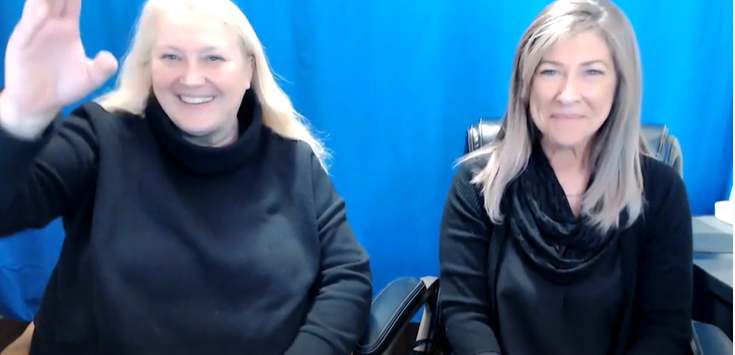Summary Below.
Interpreters Ava Hawkins and Carla Dupras, both codas, are here today to discuss codas and their continued influence on the interpreting profession. Both codas and longtime interpreters, Ava is from Winnipeg, Manitoba, and Carla was born and raised in Edmonton, Alberta.
In Canada, there is an interpreting organization known as CASLI, Canadian Association of Sign Language Interpreters, previously called AVLIC, Association of Visual Language Interpreters of Canada.
The United States has a comparable organization: RID, Registry of Interpreters for the Deaf.
Did you know these two organizations were established by codas? The driving force behind the codas were Deaf Community leaders, desperate for professional interpreters to accommodate the rights and growing need of the Deaf Community. The Deaf Community was the biggest advocate for professional interpreting services.
Before ‘professional interpreters’ came about, hearing children often worked behind the scenes, interpreting for their deaf parents at family gatherings, church events, doctor appointments and more.
Wonderfully, the establishment of these two organizations in the US and Canada led to much growth within both communities, Deaf and interpreting. Educational programs were established. Deaf teachers were hired to teach ASL, Deaf culture and interpreting skills, which resulted in more certified interpreters and higher quality of interpretations. It was a great opportunity for all involved.
There is often some confusion with “CODA” and “coda.” The spelling of “CODA” in capital letters refers to the organization, Children of Deaf Adults International. The spelling of “Coda” or “coda” refers to the person, a Child of Deaf Adult(s).
There is a universally accepted sign for “Coda” or “coda.” It is a C handshape with your dominant hand, starting at the belly button, and moving upward in one motion, stopping at the chest area. It is also acceptable to fingerspell the word: C-O-D-A.
CODA International was established in 1983 by coda Millie Brother, to connect a group of people with different cultures and languages, who all have one thing in common: a hearing child, raised by a deaf adult. Through her research, Millie was shocked to find many codas who shared similar experiences.
The first official CODA International meeting was held in Fremont, California in 1986.
Additionally, CODA International has scholarships available to members for college, university or to take applicable courses.
This year, 2022, is the 40th year anniversary of CODA International! The conference will be held in Korea, 29 June to 2 July 2022.
There are also two other international conferences in 2022: WFD, World Federation of the Deaf and WASLI, World Association of Sign Language Interpreters, are hosting conferences.
Participants are able to join all three conferences if interested. Remember, CODA International does require membership to participate.
Carla reflected on her first CODA International conference in Arizona, 2015.
She entered the conference, glanced around, and was rendered speechless at the recognition of other codas: people signing and talking, loud movements, facial expressions all too similar to her own. She felt like her heart and soul were in that room, connecting to all the other codas with her shared experience.
After 2015, Carla has continued to attend CODA International conferences. She recognized that the term ‘coda’ is how she identifies herself; she is proud to call herself a coda.
Ava has been attending CODA International conferences since the induction.
In Canada, it is rare to have multiple generations of deaf family members; the typical number is three or four generations. But Ava has 8 generations of deaf family members.
When attending a CODA International conference, Ava met two codas who also had 8 generations within their family; one from Ireland and another from Australia. They both spoke English, albeit with an accent from their relative countries; even their sign languages were different. One similarity between the three codas were body movements and facial expressions; just like a coda. The three became lifelong friends.
Carla and Ava may have felt alone in the world: a hearing person in a deaf family. They have learned that is not the case. All over the world there are codas who share the same experience, creating lasting relationships, almost like family.
Carla did not mean to become a professional interpreter.
Growing up, Carla felt communicating with her parents was limited because of her lack of ASL skills. She took ASL classes to communicate more deeply with her parents, and to build a stronger relationship. The ASL classes not only provided information about the language in terms of classifiers, grammar and structure; it also taught her about Deaf culture.
Upon graduating from the ASL classes, her teacher recommended the interpreting program.
Carla had never seen a professional interpreter, specifically with her parents. It was always her role to facilitate the communication. Interested in seeing what the program was like, Carla enrolled. She has been working as a professional interpreter ever since.
Ave also grew up interpreting for her parents. She grew tired of interpreting and had dreams of pursuing another career. Before long, a childhood friend asked Ava to interpret a few college courses one year. Ava never stopped interpreting after that; it was an unexpected entry into the interpreting profession.
When Carla studied in her interpreting program, there were no resources to support codas or deaf people learning the interpreting process. Even now, sign language interpreting programs are still not providing the best resources to accommodate the needs of codas and deaf people, and support their development. There are so many resources, research and publications that are available and need to be utilized. Codas and deaf people bring so much to the profession, but they are often under-utilized. It is time for a change.
When codas and the Deaf community are involved in developing interpreting programs, the quality of interpreters is elevated significantly.

